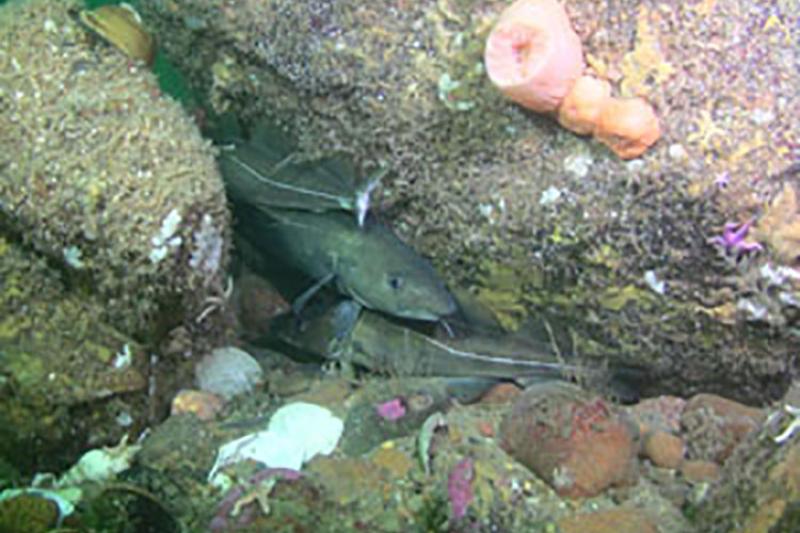Healthy habitats are productive habitats. They provide food and shelter for fish and help to maintain sustainable fish populations and fisheries that produce the seafood that we all love and depend on. Everyone benefits when marine habitats are protected from the effects of fishing.
Fish Rely on Healthy Habitats for Growth and Survival
Fish that live on or near the bottom of the ocean need food and places to hide from predators in order to survive and grow large enough to reproduce. Rocky habitats, especially those with lots of attached plants and animals like sponges, mussels, and anemones, are ideal habitats for many species of fish. These habitats are also the most vulnerable to impacts from commercial fishing gear. Nets and dredges that are towed over the bottom of the ocean can disturb bottom habitats, removing and damaging plants and animals that live there. Disturbed habitats provide fish with less food and less shelter from predators. Some habitat organisms grow and form very slowly. Once they are removed or damaged, it can take years for them to be replaced. As a result, if these vulnerable bottom habitats are fished too heavily they may never fully recover from the effects of fishing and are no longer healthy habitats for fish.
Types of Towed Fishing Gear
In New England and the Mid-Atlantic, fishermen use three primary types of towed commercial fishing gear: bottom trawls, scallop dredges, and clam dredges. Other gears such as lobster traps remain in place while fishing and have very little effect on bottom habitats.
Bottom Trawls
Bottom trawls are large nets that open wide when towed behind a fishing vessel. The opening can be as wide as 60–100 feet. The net is kept open by two doors or “otter boards” attached to each side of the net that dig into the bottom. The line that runs across the bottom of the net and drags over the bottom is called the footrope or the sweep. Round rubber cookies or “rock hoppers” are often fixed at regular intervals to the sweep to keep it slightly off the bottom and prevent snagging. Trawl tows can last as long as five or six hours.
Dredges
Scallop Dredges
Scallop dredges are heavy chain dredges with metal frames. They are towed primarily in sand, but they are also used in rocky habitats. The dredges used in the offshore fishery are typically 15 feet wide and 15–20 feet long. They are often towed in pairs, one on each side of the vessel. Scallop dredges are designed to skim over the bottom; they have more impact in rough, rocky habitats. Where scallops are plentiful, tows can last less than an hour.
Clam Dredges
Clam dredges are also large metal dredges that look like cages. They use hydraulic pressure to inject water into the bottom to a depth of 8-10 inches that dislodges the clams from the sediment. For this reason, they can have more impact than bottom trawls and scallop dredges. Clam dredges used in deeper water are 15 feet wide and fished from large vessels, often in pairs. Those used by smaller inshore vessels are typically 4-6 feet wide. Clam vessels tow back and forth in the same location as long as they keep catching enough clams to make it worthwhile, then they move to a new area.
Reducing the Effects of Fishing on Marine Habitats
We work to reduce the negative effects of fishing by:
- Requiring use of fishing gear that has less bottom contact.
- Reducing the amount of fishing activity.
- Closing sensitive habitat areas to gear types that cause damage.
Commercial fisheries in the Greater Atlantic region are much more regulated and efficient now than they used to be. Bottom trawl and dredge activity has decreased about 50 percent during the last 15-20 years. Also, fishermen have worked collaboratively with NOAA and other partners to design and test new gears that are more efficient, cause less bottom disturbance, and catch fewer unwanted fish and invertebrates that are discarded at sea.
We work closely with the two regional fishery management councils in the region to minimize impacts on habitat. Together, we have created habitat management areas that are closed year-round to bottom trawling, scallop dredging, and clam dredging. There are currently seven discrete habitat closed areas in New England that cover 2,635 square miles—slightly more than the state of Delaware. There is also a very large coral protection area beyond the edge of the continental shelf in the Mid-Atlantic where fishing with most types of bottom-tending gear is prohibited. Additional coral protection zones will soon be implemented in two small rocky bottom areas in the Gulf of Maine and beyond the shelf edge on Georges Bank.



